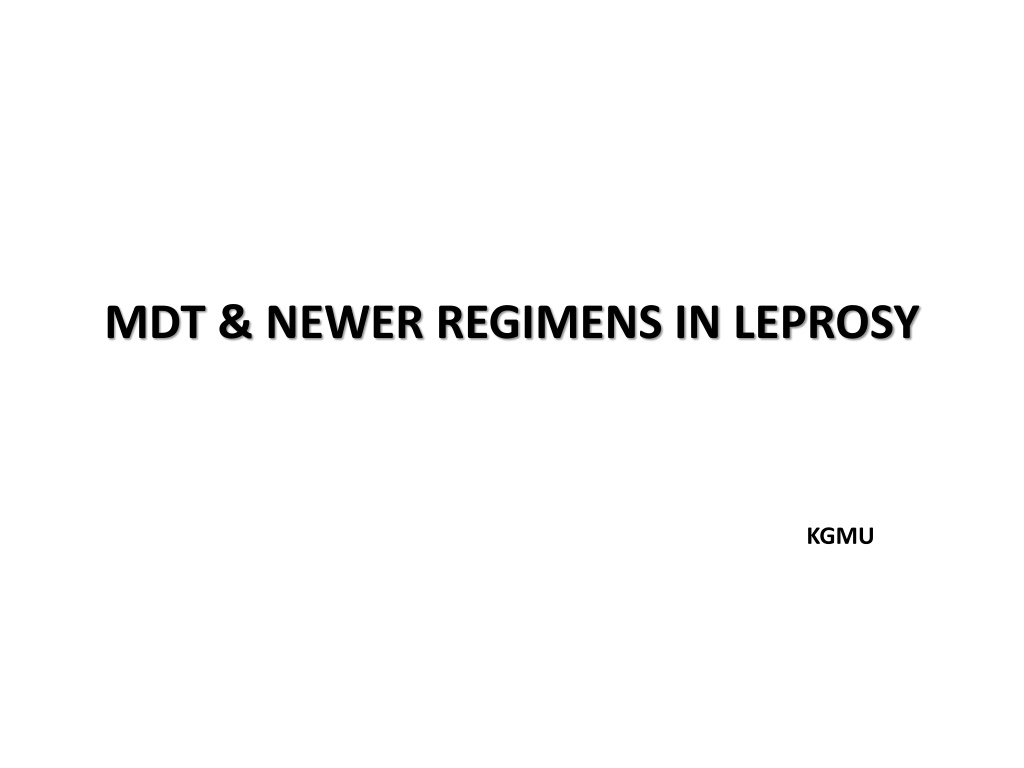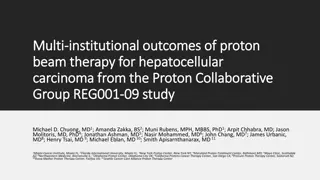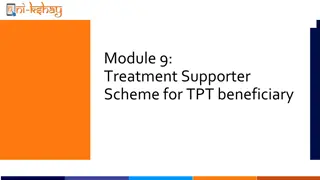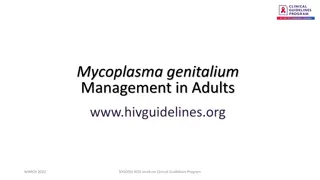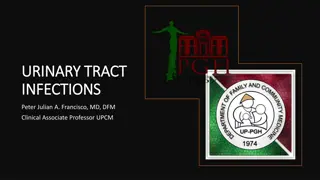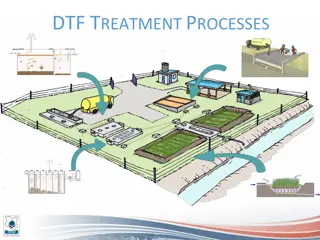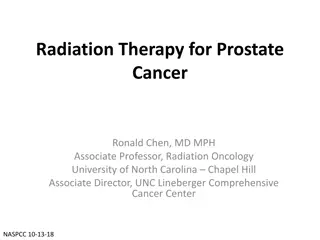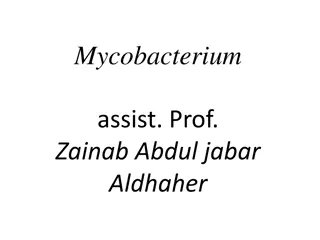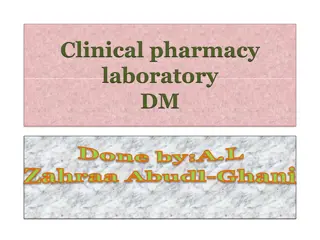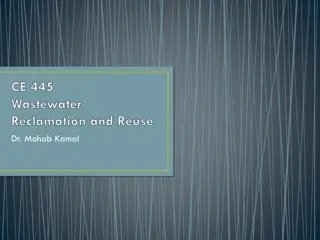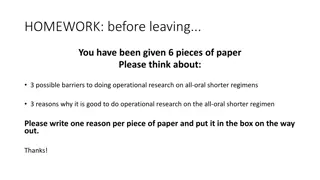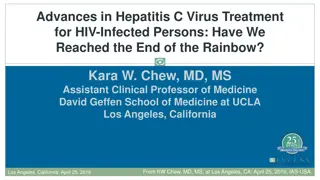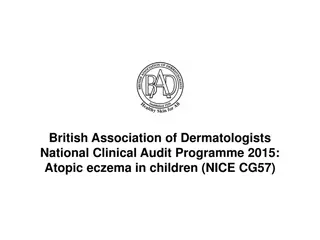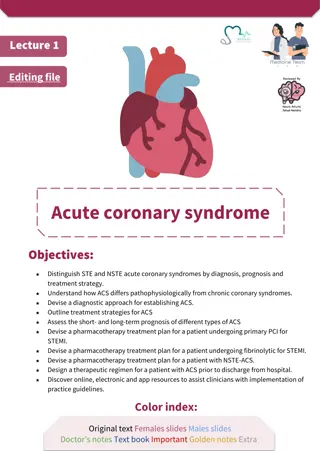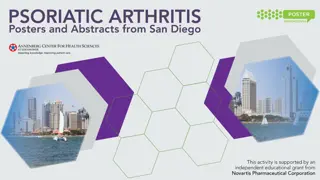Evolution of Leprosy Treatment Regimens
History and evolution of treatment regimens in leprosy, from pre-antibiotic era with Chaulmoogra oil to WHO-recommended MDT regimens. Learn about the top five states in India with the highest number of leprosy cases and the challenges faced in detecting cases late.
Download Presentation

Please find below an Image/Link to download the presentation.
The content on the website is provided AS IS for your information and personal use only. It may not be sold, licensed, or shared on other websites without obtaining consent from the author. Download presentation by click this link. If you encounter any issues during the download, it is possible that the publisher has removed the file from their server.
E N D
Presentation Transcript
Top five states in India which have highest number of leprosy cases State 2009-10 2010-11 2011-12 2012-13 Uttar Pradesh 27,473 25,509 24,627 24,222 Bihar 21,431 20,547 17,801 22,001 Maharashtra 15,071 15,498 17,892 18,715 West Bengal 11,453 10,321 12,169 11,683 Gujarat 7,373 7,309 7,496 9,010 Most leprosy cases detected late Umesh Isalkar, TNN | Jan 30, 2014
Introduction: History Pre Antibiotic Era Chaulmoogra oil / Hydnocarpus oil Obtained from the fruit ( seed) of a tree native to coastal regions ( ghats ) of South East Asia( India and Burma) It was 1stformally described by Mouat (1854) Used with camphorated oil (with added resorcin) Orally, intradermal and topical Response was inconsistent ( LL) Activity against M. leprae in the mouse footpad (Levy 1975)
Evolution of treatment regimens in Leprosy S.N O REGIMEN DISEASE TYPE YEAR DURATION 1 DDS monotherapy MB 1960s to 1980 Lifelong (continous) 2 WHO MDT (21 days intensive therapy subsequently reduced to 14 days) MB 1981 24 mts or till SSS is ve 3 WHO MDT(modified by IAL and NLEP) MB 1983 24 mts or till SSS is ve 4 WHO MDT (FDT 24) MB 1994 24 mts (daily) 5 WHO MDT ( FDT 12) MB 1997 12 mts (daily) 6 WHO MDT (FDT 6) PB 1981 6 mts (daily) 7 ROM -12 MB 1995 12 mts (monthly) 8 ROM 6 PB 1995 6 mts (monthly) 9 RO (continuous treatment for 28 days) PB/MB 1992 28 days (daily) 10 ROM - 1 SSLPB 1997 1 day (single dose) 11 PMMx - 1 MB 2000 1 day (single dose)
Introduction: History The Sulphone Monotherapy Era The introduction of effective antimicrobial treatment for leprosy, first with the sulphones by Faget in 1943 Initially promin and solapsone, intravenous injectable sulphones, were utilised, but these injectables were soon abandoned for oral dapsone Monotherapy with dapsone became the standard of care throughout the world in 1950s
R MDT ( WHO) In 1981, WHO recommended a classification for operational purpose as pauci- and multi-bacillary (PB and MB) In the beginning of 1981, WHO recommended to treat MB cases till two consecutive skin smear negative results were achieved Subsequently, in 1992, fixed duration therapy (FDT) was introduced where MB patients were given treatment for 2 years or 24 pulses in a period of 36 months by which time the dependability of skin smear was removed Later, in 1995, WHO redefined the therapy with 12 pulses of MDT MB In 1997 shortening of MB-MDT to 12 doses were accepted by Indian govt.
R MDT ( WHO) The duration of PB therapy for 6 months, or six pulses to be completed within 9 months. Lepromin-positive Residual organisms - tackled by the immunity of the host
Need for new Drugs and Regimens 1. Duration of treatment is too long (operational point of view). 1. Dapsone and Clofazimine are only weakly bactericidal against M. leprae, results in long duration of treatment and low compliance rate. 2. Daily dosing of Dapsone and Clofazimine cannot be supervised. 3. Some patients cannot tolerate any of the drugs in MDT.
Newer chemotherapeutic agents for Leprosy 1 Fluoroquinolones Ofloxacin, Pefloxacin, Sparfloxacin, Temafloxacin, Moxifloxacin and Sitafloxacin 2 Tetracyclines Minocycline 3 Macrolides Clarithromycin 4 Ansamycins Rifabutin, Rifapentin, R- 76-1 5 Dihydrofolate reductase inhibitors Brodimoprim and K- 130 6 Fusidic acid 7 Beta lactam antibiotics
Fluoroquinolones Act by inhibiting the alpha sub unit of the enzyme DNA gyrase Ofloxacin Bactericidal against M leprae (less so than a single dose of rifamicin) In a trial of OFLO alone and its combination with dapsone (DDS) and clofazimine (CLF), 24 patients with newly diagnosed lepromatous leprosy were allocated randomly to three treatment groups and treated for 56 days by OFLO daily 400mg OFLO + 100mg DDS+ 50mg CLF daily plus 300mg CLF once every 28 days More than 99%, > 99.99%, and > 99.99% of the viable M leprae were estimated to be killed by 14, 28, and 56 days of treatment respectively. Ji B,Perane EG, Petinon C, et al. Clinical trial of ofloxacin alone and in combination with dapsone and clofazimine for the treatment of lepromatous leprosy, Antimicrob Ag Chemother 1994;38:662-667
Macrolides It acts by linking to the 50s sub-unit, thus inhibiting bacterial protein synthesis Clarithromycin (CLARI) appears the most promising Less bactericidal than RMP When administered in a dosage of 500mg daily to leprosy patients, the drug killed 99% of M leprae by 28 days, and 99.9% by 58 days. Jacobson RR. Needed research in the chemotherapy of leprosy related to the individual patient, Int J Lepr, 1996; 64 Suppl:S16-S 20.
Minocycline It binds reversibly to the 30S unit of the ribosome thus blocking the binding of aminoacyl transfer RNA to the messenger RNA-ribosomal complex, thereby inhibiting protein synthesis its lipophilicity permits it to penetrate the bacterial wall The drug is bactericidal against M leprae The clearance of viable M leprae from the skin by minocycline was faster than that reported for CLF and DDS but slower than that for RMP and similar to that by OFLO. Lesser reactions especially in lepromatous cases Gelber RH, Fukuda K, Byrd S, et al. A clinical trial of minocycline in lepromatous leprosy. Med J, 1992;304:91-92.
Combination of newer anti - leprosy drugs Because of greater bactericidal activity, the addition of OFLO, MINO, or CLARI or some combination of these drugs to WHO/ MDT or substituting one of these drugs might permit shortening of the treatment The results of a trial now in progress of a combination of OFLO and RMP administered daily for one month is awaited Earlier a one month trial of RMP combined with MINO (both given daily) for one month has been reported to give satisfactory results in a mixed group of 20 PB and MB patients and no relapses were reported after 2 years of follow-up
ROM therapy ROM is the first fully supervisable, monthly administered regimen, started in 1998 Its efficacy of monthly doses for treatment of MB and PB leprosy has been tested in field trials in three different countries A third category has been introduced as single lesion paucibacillary leprosy (SLPB), where single dose rifampicin 600 mg, ofloxacin 400 mg, and minocycline 100 mg (ROM) therapy was recommended for cure Ji B. Bactericidal activity of a single-dose com-bination of ofloxacin plus minocycline, with or without rifampin, against Mycobacterium leprae in mice and in lepromatous patients. Antimicrob Agents Chemother.1998;42:1115 20 Daumerie D. Current World Health Organization-sponsored studies in the chemotherapy of leprosy.Lepr Rev. 2000;71:88 90 Efficacy of single dose multi drug therapy for treatment of single lesion paucibacillary leprosy. Single lesion multi centered trial group. Indian J Lepr. 1997;69:121 9
ROM therapy Advantages of ROM therapy Improved compliance Absence of skin pigmentation Decreased chances of severe reactions Disadvantages Less protective for single lesion and PB than MDT
ROM 12 Therapy Ofloxacin and minocycline have been shown to be more bactericidal than dapsone and clofazimine in both mice and clinical trials Four studies compared single dose ROM with WHO-MDT for treating PB leprosy and combining these studies it was found that single dose ROM is slightly less effective than WHO-MDT with a relative risk of 0 91 (95% confidence intervals 231%) but still has a very high cure rate Only two studies have been reported using multiple doses of ROM in lepromatous leprosy (LL). One in the Philippines by Villahermosa et al. Lepr Rev. 2012 Sep;83(3):241-4. Developing new MDT regimens for MB patients; time to test ROM 12 month regimens globally. Lockwood DN, Cunha Mda G.
ROM 12 Therapy Comparing 21 patients with BL and LL who were given either monthly ROM or the standard MDT which comprised monthly rifampicin (600 mg), and clofazimine (300 mg) with daily dapsone (100 mg) and clofazimine (50 mg) for 24 months These patients had a mean Bacterial Index (BI) of 4 (range 2 7 5 1) at entry to the study and it fell to 1 18 (range 0 3 5) A study done in Brazil had a similar design, allocating patients to either monthly ROM or MB-MDT. These patients mostly had LL and both groups had a similar fall in BI (3 5 to 2 5) after 24 months of treatment and similar clinical and histological improvements In the Philippines study the BI continued to fall after the completion of antibiotic treatment and no relapses were recorded during the subsequent 64 months after treatment
C ROM Therapy 300 patients, detected on active search in Agra district, who had single lesion leprosy but no nerve thickening, were randomly allocated (using random number table) to two treatment groups, 151 to ROM and 149 to C-ROM for 2 years. All the patients were given single dose of ROM or C-ROM (clarithromycin 250 mg) and followed up every 6 months for 5 years for disease status, cure rate, reaction and relapse
C ROM Therapy Results: The cure rate at 2 years was 93 1% in ROM and 91 4% in C-ROM group. By this time three relapses had occurred in the ROM group while two patients were found to have relapsed in the C-ROM group. Thus, there was no statistical difference in relapse rates (2 1% vs. 1 41%, P 0 287) in the two groups. Long term observations over 3 5 years revealed nine relapses (five in ROM, four in C-ROM) giving relapse rate of 1 05/100 Person years in ROM and 0 90/100 person years in C-ROM group again no significant difference was observed (P 0 87)
C ROM Therapy Conclusion: The study shows that addition of clarithromycin to ROM does not significantly improve the efficacy as measured in terms of cure rates and relapse rates in single skin lesion leprosy patients. A randomised controlled trial assessing the effect of adding clarithromycin to Rifampicin, ofloxacin and minocycline in the treatment of single lesion paucibacillary leprosy in Agra District, India ANITA GIRDHAR, ANIL KUMAR & BHAWNESWAR KUMAR GIRDHAR Epidemiology and Clinical Divisions, National JALMA Institutefor Leprosy & Other Mycobacterial Diseases (ICMR), Taj Ganj,Agra 282001, India Lepr Rev (2011) 82, 46 54
ROM Trial (intermittent Therapy) ROM therapy ( R 600 mg, O 400 mg, M 100 mg) / month Given once a month in both PB and MB Objective of study Clinical response Side effects Reactions ( ENL and reversal) Feasibility for mass programs
ROM Trial (intermittent Therapy) 12 or 24 doses of ROM once monthly in MB cases 3 or 6 doses of ROM in PB cases Results were Decrease in BI and clinical regression 10 MB cases and 11 PB cases developed reactions ( type 1 and type 2)
RO (Continuous therapy for 28 days) 4 combinations were tried 1. MDT 12 doses 2. MDT 12 doses + ofloxacin 3. Rifampicin + ofloxacin (RO) 4. MDT 24 doses In all group fall in BI were comparable More chances of relapse in RO therapy ( > 38% in a 5 yr follow up)
Uniform MDT ( U MDT) Uniform leprosy treatment that would not require disease classification Therapy given for 6 months period Rifampicin 600 mg/mt, Dapsone 100 mg daily and clofazimine at 50 mg/day and 300 mg/mt Advantage Shortens the course of treatment Increases patient adherence to treatment Improves the performance of health workers in the field
Uniform MDT ( U MDT) One is reducing the duration of treatment for MB patients from 12 months to 6 months. Evidence from experimental studies suggests that 2 3 months MDT is capable of killing almost all viable bacilli in the mouse footpad model (Ji et al. 1996a; Banerjee et al. 1997). An experimental study further suggests that the rifampicin-resistant mutants in an untreated lepromatous patient are likely to be eliminated by 3 months daily treatment with dapsone clofazimine combination and by that time rifampicin with three monthly doses would have killed over 99.999% of the viable Mycobacterium leprae (Ji et al. 1996a). Loss of infectivity of M. leprae after only 1 month of WHO MB MDT or with a single dose of rifampicin was documented (Ji et al. 1996b)
Uniform MDT ( U MDT) A. During the follow-up, only 27 patients (0.9%) developed new lesions 78% of which were caused by reactions Six patients had clinically confirmed relapse 2.9% of patients were lost during the follow-up period. In general, the PB patients responded better than the MB patients (27% vs. 6%, p < 0.001). Too short to treat MB leprosy. Other drawbacks Clofazimine is relatively expensive drug (increase cost of treatment of PB cases) Unethically expose patients to additional risk of side effects B. C. A clinical trial for uniform multidrug therapy for leprosy patients in Brazil 8,755 The trial was coordinated by the National Institute of Epidemiology of the Indian Council of Medical Research. From November 2003-May 2007, 2,912 patients (India, 2,746, China, 166) R- MDT vs U-MDT
Accompanied MDT ( A- MDT) Recommended by WHO specially for field programs Providing certain patients with a full course of treatment on their 1st visit Medicines to be given to a person who will provide the supervise treatment Advantage User friendly and flexible Suitable for mobile population Remote areas, migrant labourers Urban slums, during wars
Accompanied MDT ( A- MDT) Disadvantages of A - MDT It was wishful thinking rather than evidence based thinking Who should be chosen for giving medications to the patient? How to train health workers to supervise A MDT? Routine or in special situation?
Moxifloxacin based Regimens Most powerful bactericidal agent aginst M. leprae Synthetic broad spectrum antibiotic with inhibition of the DNA gyrase. Preliminary observations on 54 patients in Mumbai 2009 (Rifampicin 600 mg + moxifloxacin 400 mg + minocycline 200 mg)/ month 6 months for smear negative 12 months for smear positive
Moxifloxacin based Regimens Results Remarkable clinical regression within 2 3 months in all cases No S/E seen with drugs Mild ENL was noticed in one patient and type 1 reaction in another patient Still long term observations are needed to draw any conclusions
Moxifloxacin based Regimens Other trials 1. A combination of moxifloxacin with rifapentine and minocycline ( PMMx) was recommended for human trial by Ji and Grosset in 2000 In a clinical trial by Eleanor and Pardillo et al in 2008 moxifloxacin alone was proved to be highly effective in a group of 8 MB patients 2.
Ofloxacin based Regimen Recently antimicrobials of the fluoroquinolone class (pefloxacin and ofloxacin) were found far more effective against Mycobacterium leprae in studies with both mice and patients than dapsone and clofazimine As multicentre trial participants, evaluation of the therapeutic efficacy, in terms of rate of relapse, of two new multidrug regimens containing ofloxacin, comparing them to 1 year and 2 years of standard WHO-MDT regimen in multibacillary (MB) leprosy patients.
Ofloxacin based Regimen A total of 198 MB patients were recruited to participate in a randomized, double-blind trial. 53 patients were treated with 1 year of WHO-MDT (a regimen including dapsone, clofazimine, and rifampin), 55 patients received 1 year of WHO-MDT plus an initial 1 month of daily ofloxacin 63 patients were treated with 1 month of daily rifampin and daily ofloxacin 27 were treated with 2 years of WHO-MDT Patients were regularly monitored for signs of relapse, in at least 7 years follow-up after being released from treatment.
Ofloxacin based Regimen Relapse occurred in those treated with 1-month regimen alone at a significant higher rate (P < 0.001): 38.8%, whereas in the other three regimens that included WHO-MDT it ranged from 0 to 5% This study found that a short-course treatment for MB patients with rifampicin-ofloxacin combination had a higher failure rate. The addition of one month of daily ofloxacin to 12 months MB WHO-MDT did not increase its efficacy epr Rev. 2012 Sep;83(3):261-8. OFLOXACIN multicentre trial in MB leprosy FUAM-Manaus and ILSL-Bauru, Brazil. Cunha Mda G, Virmond M, Schettini AP, Cruz RC, Ura S, Ghuidella C, Viana Fdos R, Avelleira JC, Campos AA, Filho B.
Quadruple regimen In a study at Belgium, MB patients were given weekly supervised doses of rifampicin, ofloxacin, clofazimine, and minocycline for 6 weeks Initial results are highly encouraging. Relepse rate was only 2% However, long-term follow-up is needed in all these shortened regimens World Health Organisation. Report of the ninth meeting of the WHO technical advisory group on leprosy control: Cairo, Egypt, 6-7 March 2008. Lepr Rev. 2008;79:452 70
Other Regimens for special situations(WHO) A. Allergy or inter-current disease such as chronic hepatitis or severe dapsone toxicity B. Infected with rifampicin - resistant M. leprae C. Who refuse to accept clofazimine
Other Regimens for special situations(WHO) Who refuse to accept clofazimine In 1993 WHO advocated daily ofloxacin 400 mg or minocyclin 100 mg or Monthly ROM for 24 months
Other Regimens for special situations(WHO) Allergy or inter-current disease such as chronic hepatitis or Severe dapsone toxicity PB cases Dapsone should be stopped Clofazimine sustituted for dapsone for a period of 6 months MB cases Dapsone should be stopped No further modification is required
Other Regimens for special situations(WHO) Infected with rifampicin - resistant M. leprae Commonly also resistant to dapsone In these cases their treatment depends almost entirely on clofazimine Clofazimine in combination with ofloxacin and minocycline is most effective
Infected with rifampicin resistant M. leprae PB cases (50 mg of clofazimine + 400 mg of ofloxacin + 100 mg minocycline or 500 mg of clarithromycin) daily for 6 months MB cases Daily administration of any two drugs ( minocycline 100 mg, ofloxacin 400 mg, clarithromycin 500 mg) along with clofazimine 50 mg daily for 6 months followed by daily ( 50 mg of clofazimine + 100 mg of minocycline or 400 mg ofloxacin) for at least additional 18 months
Intensive phase regimens While the initial results of such intensive short course regimens have been described to be promising, a larger group of patients must be followed up for a much longer period of time in order to demonstrate that the relapse rate is satisfactorily low Compromised immunity Multibacillary disease with a very high bacterial load Intensive regimen for 6 12 months Continuous phase for another 18 months Rifapentine, 900 mg, appears superior to rifampin in these combinations
Intensive phase regimens Proposed newer intensive drug regimens for rifampin- sensitive multibacillary patients include rifapentine, 900 mg; moxifloxacin, 400 mg; and clarithromycin, 1000 mg (or minocycline, 200 mg), all once monthly for 12 months For rifampin-resistant patients, moxifloxacin, 400 mg; clofazimine, 50 mg; clarithromycin, 500 mg; and minocycline, 100 mg, are given daily, supervised for 6 months. The continuous phase of treatment could comprise moxifloxacin, 400 mg; clarithromycin, 1000 mg; and minocycline, 200 mg, once monthly, supervised for an additional 18 months
Role of immunotherapy Two problem existing after chemotherapy Persisters Large pool of dead oraganism Immunomodulators that can stimulate CMI have been applied to reduce this pool problem of persisters.
Role of immunotherapy These agents can be divided into three broad categories: 1. Drugs such as levamisole and zinc. 2. Antigenically related mycobacteria such as BCG, ICRC bacillus, BCG plus killed M. leprae, Mycobacterium w (Mw), and M. vaccae. 3. Other immunomodulators such as transfer factor, recombinant interferon (IFN ), and interleukin-2.
Conclusion The evolution of WHO MDT treatment regimens has undergone a sea change due to consistent research and painstaking follow-up, which is necessary in a chronic disease like leprosy to draw practical conclusions to understand the efficacy of several drugs. Time duration of treatment of MB leprosy is still in debate with increase cases of relapse and persisters. Future hope lies in combination therapy of MDT and other newer regimens and immunotherapy.
References Rook s book of dermatology 8th edition. Fitzpatrick book of dermatology. Indian association of Dermatologist, Venerologist, and Leprologist. Lever histopathology of the skin. IADVL journal JAMA Dermatology jounal IAL textbook of leprosy Leprosy review / www.leprahealthinaction.org Hastings book of Leprosy
